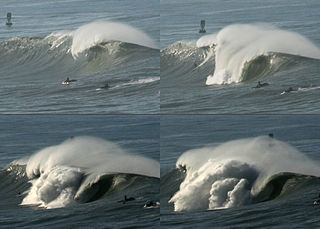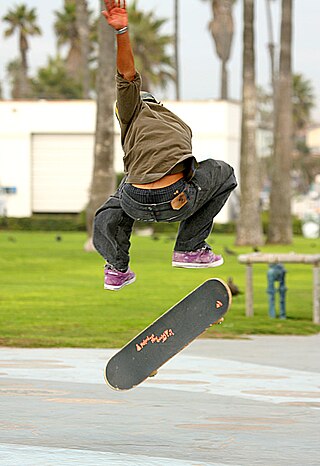
Surfing is a surface water sport in which an individual, a surfer, uses a board to ride on the forward section, or face, of a moving wave of water, which usually carries the surfer towards the shore. Waves suitable for surfing are primarily found on ocean shores, but can also be found in standing waves in the open ocean, in lakes, in rivers in the form of a tidal bore, or in wave pools.
Boardsports are active outdoor sports that are played with some sort of board as the primary equipment. These sports take place on a variety of terrains, from paved flat-ground and snow-covered hills to water and air. Most boardsports are considered action sports or extreme sports, and thus often appeal to youth. Some board sports were marginalized in the past. However, many board sports are gaining mainstream recognition, and with this recognition, they have enjoyed wider broadcast, sponsorship and inclusion in institutional sporting events, including the Olympic Games.

A surfboard is a narrow plank used in surfing. Surfboards are relatively light, but are strong enough to support an individual standing on them while riding an ocean wave. They were invented in ancient Hawaii, where they were known as papa he'e nalu in the Hawaiian language, and were usually made of wood from local trees, such as koa. They were often over 460 cm (15 ft) in length and extremely heavy. Major advances over the years include the addition of one or more fins (skegs) on the bottom rear of the board to improve directional stability, and numerous improvements in materials and shape.

A longboard is a type of skateboard typified by longer decks and wheelbases, larger-diameter and softer (lower-durometer) wheels, and often lower riding height compared to street skateboards, though there is wide variation in the geometry and construction of longboards. Among the earliest types of skateboards, longboards were inspired by surfing, with early longboards drawing from the design of surfboards, resembling and mimicking the motion of riding a surfboard, but adapted to riding on streets in a practice known as sidewalk surfing.

Longboarding is a variation of skateboarding typified by the use of longer boards ("decks") with longer wheelbases and softer wheels. While longboards vary widely in shape and size, compared to street skateboards longboards are designed to be more stable at speed and to have more traction due to larger wheel sizes and softer wheel durometers. While standard street skateboards may typically be between 28 to 34 inches long, longboards can range anywhere from 32 to 50 inches in length. Ride characteristics of longboards generally differ from that of street skateboards due to the use of specialized longboard trucks that have different properties than those typically used with skateboards; while street skateboards use "traditional kingpin" (TKP) trucks that are optimized for tight turning radii, ollie and flip tricks, slides, grinds, and transition skating, longboards are typically paired with "reverse kingpin" (RKP) trucks that are designed for increased stability at higher speeds, more "surfy" carving characteristics, and/or greater ride comfort for commuting over longer distances.

Mavericks is a surfing location in northern California outside Pillar Point Harbor, just north of the town of Half Moon Bay at the village of Princeton-by-the-Sea. After a strong winter storm in the northern Pacific Ocean, waves can routinely crest at over 25 ft (8 m) and top out at over 60 ft (18 m). Routinely, waves that break can be recorded on seismometers. The break is caused by an unusually shaped underwater rock formation.

Mountainboarding, also known as dirtboarding, off-road boarding, and All-Terrain Boarding (ATB), is a well-established but little-known action sport, derived from snowboarding. It could be more extreme. The sport was initially pioneered by James Stanley during a visit to the Matterhorn in the 1990s, where snow was not available. A mountainboard is made up of components including a deck, bindings, four wheels with pneumatic tires, and two steering mechanisms known as trucks. Mountainboarders, also known as riders, ride specifically designed boardercross tracks, slopestyle parks, grass hills, woodlands, gravel tracks, streets, skateparks, ski resorts, BMX courses, and mountain bike trails. It is this ability to ride such a variety of terrain that makes mountainboarding unique from other board sports.

Skip Frye is an American surfer, surfboard designer and shaper, and environmental activist.
Warren Edward Bolster was an American skateboard photographer during the mid-1970s rebirth of skateboarding.
Skurfing is a towed water sport in which an individual is pulled behind a boat on a tow rope. The sport uses a skurfboard, which is a floating platform the user balances on, similar to a surfboard but typically much shorter, with two foot-straps that prevent falling off the board and three fins positioned on the bottom that make it easier to maneuver when the board is being towed. The word itself is a portmanteau of skiing and surfing. Skurfing is often considered the precursor to wakeboarding.
Pumping is a skateboarding technique used to accelerate without the rider's feet leaving the board. Pumping can be done by turning or on a transition, like a ramp or quarter pipe. When applied to longboards, it is also known as Long distance skateboard pumping or LDP. Pumping is a technique similar to pumping a surfboard.

A skateboard is a type of sports equipment used for skateboarding. It is usually made of a specially designed 7–8-ply maple plywood deck and has polyurethane wheels attached to the underside by a pair of skateboarding trucks.

An electric skateboard is a personal transporter based on a skateboard. The speed is usually controlled by a wireless hand-held throttle remote, or rider body weight-shifting between front of the board for forward motion and rear for braking. As for the direction of travel to the right or left, it is adjusted by tilting the board to one side or the other. The classification of electric skateboards and legality of their use on roads or pavements varies between countries.
Oxbow is a brand of clothing and athletic equipment. Since its creation in 1985 in Pont-Audemer, France, Oxbow has positioned itself in the world of boardsports as an international brand. Oxbow restarted the World Longboard Championship in 1992, and sponsors athletes such as surfer Laird Hamilton and windsurfer Jason Polakow. Oxbow's Back to Powder winter event draws some of the best skiers and snowboarders in the world. The business is involved in five sports: surfing, windsurfing, kitesurfing, snowboarding, and skiing. Oxbow became an affiliate of the French group Lafuma in 2005.

This glossary of surfing includes some of the extensive vocabulary used to describe various aspects of the sport of surfing as described in literature on the subject.[a][b] In some cases terms have spread to a wider cultural use. These terms were originally coined by people who were directly involved in the sport of surfing.
Carveboarding is a boardsport that takes place on hard surfaces such as roads and sidewalks. It combines elements of surfing, snowboarding, and skateboarding, providing a riding experience that resembles surfing and snowboarding.
Donald Moke Takayama was an American professional surfer and surfboard shaper. Originally a longboard surfer, Takayama won the Master's division of the United States Surfing Champions in 1971, 1972 and 1973. Hawaiian born, Takayama learned to surf at Waikiki Beach and moved to California in the mid-1950s. Takayama died of complications from heart surgery; he is survived by his wife and four daughters.
Hamboards manufactures and sells rail-to-rail Surfskates, SUPskates, Paddles and Accessories. Most Hamboards are longer, wider and sit higher off the ground than conventional skateboards and longboards. Hamboards also turn much more than conventional skateboards. The enabling technology are the patented Hamboards Surfskate Trucks (HST), featuring 30 degrees of roll, which allows these huge boards to track and pump aggressive surf-style carving maneuvers. The patented Street Sweeper SUPskate Paddle flexes significantly, allowing the user to spring themselves along with comfort.









